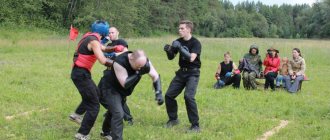It’s normal to be nervous and afraid. But “normality” has its limits. Nervousness is natural during a date or an exam. Things are bad when you start to tremble when you hear the standard question: “What time is it?” Psychotherapists have called those suffering from a fear of communication social phobias. Life is difficult for such individuals. As soon as a social phobe appears in public view - just walk down the street, ride on the subway - panic immediately begins and uncertainty sets in. Fear of others causes severe stress, seriously impairs the quality of life, and limits opportunities. A sociophobe often finds himself outside of society altogether, afraid to leave the threshold of an apartment, and becomes a prisoner of his own home. But you can get rid of the problem. You just need to change your life a little, find a good psychotherapist. He will teach you how to stop being afraid of people and forget about social anxiety.
Manifestations of anthropophobia, reasons for fear of people
A person with anthropophobia tends to avoid any interaction with society. He may have panic attacks in places with large crowds of people.
Fear of people refers to anxiety conditions that provoke the development of neuroses and depression
Psychiatrists believe that the reasons for this condition lie in the individual’s childhood. Unreasonably strict parents, who seek to correct the child’s behavior through fear and punishment, instill in him fear of people in general.
Frequent criticism and lack of praise hurt feelings and lead to low self-esteem. The individual subconsciously expects negativity from the environment towards him and strives to minimize contacts.
In psychology, the reasons for the appearance of fear of people include:
- Traumatic situations experienced in childhood, adolescence and adulthood. This can be either violence (emotional, physical, sexual), or terrorist acts, or other types of aggression from society.
- Increased suspiciousness and vulnerability combined with low self-esteem.
- Rejection, rudeness, ridicule from significant persons in adolescence or childhood.
- Bullying at school or work.
According to psychologists, the lack of “real” communication and constant “hanging out” on social networks can become a catalyst for anthropophobia in people prone to isolation and lack of self-confidence.
The lack of communication skills further lowers self-esteem; a person deliberately avoids contact with people. Over time, this leads to complete avoidance of people.
Why does fear of society arise and social phobia is born?
An individual begins to be afraid and stops trusting others when:
- bullied by classmates (for poverty, special appearance, obesity, poor academic performance). Social phobia often affects children with burns, people who stutter, and people with disabilities;
- cold, cruel parents refuse to see the child’s problems - they ignore, take the side of “enemies”, demand the impossible;
- fear of others is instilled by overprotective parents who seek to protect their child from the “cruel world”;
- unsociability of loved ones is also a potential culprit of social phobia. If parents hate inviting guests and have few friends, then the child is deprived of the opportunity to gain the necessary communication experience. The baby’s social skills remain undeveloped, and social phobia gradually develops.
Fear of others begins at 12–15 years of age. Sometimes social phobia strikes later - at the age of 16–20 years. Fear of society comes with puberty. The teenager begins to think critically. A growing individual has new responsibilities and his social circle expands. This causes a lot of stress, a desire to hide, to belong to oneself again. The teenager begins to avoid others. He gradually realizes: “I am afraid of people.” Social phobia appears.
Fear of others and shyness are similar, but different phenomena. Shyness often affects children aged 6–11 years (especially from disadvantaged families). But in adolescence it goes away. Introversion and social phobia are also different things. Those who prefer solitude are rarely afraid of others.
Symptoms of anthropophobia, how to determine the presence of anthropophobia
Fear of people can manifest itself as an independent condition or as a symptom of other psychiatric diseases and mental disorders.
According to psychologists, the lack of “real” communication and constant “hanging out” on social networks can become a catalyst for anthropophobia
The disease is characterized by:
- Fear of communicating with other people. Panic can be caused by visiting public places or simply going outside.
- Obsessive actions with which a person tries to cope with a phobia. This could be a count of some objects, for example, red cars or the number of steps taken. These could be certain gestures or filler words.
- Strong anxiety when communicating . An anthropophobe does not look his interlocutor or others in the eyes when talking. Speech is intermittent and confused, the speaker confuses himself, stuttering or long pauses between words are possible.
Pseudohypostasophobia
There are often cases when experts disagree about the reasons for the origin of any of the phobias. At the moment, scientists have no doubt about why and how pseudohypostasophobia arises, and there is already evidence that it begins its development in childhood, under the influence of some incident or a certain situation, with the participation of someone in a mask who frightened the child by their inappropriate behavior. Maybe this happened by chance at a time when no one could have thought that the baby would react negatively to the cheerful (as adults think) holiday mask. But there are cases when such a situation is planned in advance, when the presence of strong and unexpected fear is caused by a frightening rubber mask. It could be a gorilla, or a fantastic creature, especially since modern masks have a completely realistic look, and they can be associated with characters in famous horror films.
The main feature of this outfit is that if a person understands that this is just a performance, then he still has an unpleasant feeling of fear. A similar reaction is characteristic of people who have a weak psyche and a wonderful imagination. But, be that as it may, according to psychologists, such entertainment has a negative impact on children. Among this category of patients, there are also those who develop a feeling of fear at the sight of masks alone, even if people are not wearing them. During a conversation with a psychotherapist, some patients express the belief that the mask is waiting for the right moment when they are sleeping in order to take over their thoughts and minds, and even take over their lives.
How is it different from social phobia?
Both disorders are classified as anxiety-phobic. But a social phobe experiences fear when visiting places with large crowds of people or social events.
Anthropophobia can be determined after a conversation with a psychiatrist or psychotherapist
He is afraid of public speaking, corporate events, family gatherings with a lot of relatives. In this case, a person can communicate without any problems with two or three people.
A sociophobe can work in a small team, have a close friend, and be able to build personal relationships.
An anthropophobe , as a rule, cannot communicate with people at all. He is overcome with anxiety at the thought of meeting a random passerby, the need to contact the salesperson in the store, or the customer service operator.
A person with such a phobia is unable to turn to others for help, even in difficult situations. Anthropophobes have no friends and a complete lack of personal life. They try to rarely leave the house.
What to do?
Dealing with social anxiety is not easy. Sometimes it is enough just to correct the worldview and, accordingly, behavior. In other cases, medications may be necessary, including those that relieve symptoms, such as sleep aids.
I want to introduce you, dear readers, to an effective training exercise, a way to change your worldview, and give general recommendations for correcting your life.
Training exercise
You may be surprised, but art therapy is an effective means of combating all phobias, including social phobia.
- Take a sheet of paper and draw whatever is in your head. It doesn’t matter what you draw, how you draw, or whether you know how to draw. Just “pull” the fear and anxiety out of yourself.
- After you finish, try to analyze the drawing (if it doesn’t work, it’s okay). It is possible that the silhouette of a person from the past who provoked social phobia, or a situation from school childhood, that is, the very root cause (premise of the phobia), will inadvertently “pop up” from the subconscious and be visualized.
- After that, take a new sheet of paper and try to describe your feelings and thoughts that arose in the process of how you created. It often happens that a person cannot complete this part, because he is unable to remember those feelings. This is due to what your subconscious drew.
- The last stage is burning the drawing or both the drawing and the notes. As an alternative, you can simply write down your fears, anxieties, thoughts and burn them.
This visualization method is very effective, despite its simplicity.
Down with self-concentration
Focusing on your own behavior in a critical situation for a person and when unwanted external signs (for example, blushing) appear can play a cruel joke. The opinion that in order to get through a problem situation “smoothly” you need to control yourself is wrong. Noticing that a person is sweating, he will begin to sweat even more.
That is, by concentrating too much on oneself and trying to control the situation, a person drowns in his phobias and distorted perception of himself.
- He has no way to notice people's reactions and support. Take a break for a second and you will notice interest in people's eyes, acceptance of you along with all your features.
- However, the same thing works if you notice that someone from the audience (considering a public speaking situation) is skeptical about you. But even here it should be regarded as a silent request to clarify the material. And even if this is criticism, then a constructive form is necessary for a person (this is important to understand).
- If we are talking about inadequate criticism, then it is not even worthy of your attention.
So, trying to completely control his behavior, a person loses control over the situation. A kind of vicious circle arises. In order to calm down, you need to switch your attention.
For example, you start having a somatic cough attack in an inappropriate place. You understand that you are already having a hard time holding back, but you can’t help but think about it, which is precisely forbidden. In this case, just start counting or remembering a verse to yourself. You yourself will not notice how distracted you are, and the attack will pass.
General tips and tricks
In the fight against social phobia there is no single scheme or plan, in general, as in the correction of any psychological disorder. The work plan depends on the severity and direction of fear of society, as well as its causes. However, some general recommendations can be made:
- Find a support group. Let’s start with people you know on the Internet. Ideal, of course, to have real contacts (family, love, friends).
- Understand that there are no perfect people, and you cannot please and please everyone. If you are afraid to meet girls because of an unhappy history, then you still shouldn’t pretend to be someone else. Be yourself. You can't lose what you don't have. And trying and making mistakes is normal and useful. All life, starting from birth, is trial and error. After all, walking was once scary, don’t you agree? And it hurts.
- Self-confidence and adequate self-esteem are the basis for getting rid of social phobia. Work on your self-confidence, study yourself, find your strengths and focus on them. Every person is terrible in some ways, but beautiful in some ways. But there is no such thing as being wonderful or terrible in everything. This is a reality that needs to be accepted. To correct self-esteem and confidence, you can take training courses or find information on the Internet. You can download entire collections of exercises, for example, Wayne Dyer’s work “How to Believe in Yourself.” The motto of this book is: “When you believe, then you will see.” Unfortunately, in such a narrow article and addressing a general audience, I cannot give examples of exercises. It's very individual. Please find the material and choose something suitable for yourself.
- Break your comfort zone. No matter how it sounds, the “wedge by wedge” principle often works with social phobia. You literally have to break yourself. A club of similar interests (perhaps you are creating something) would be a great start. Find what interests you (poems, music) and share it with your friends. The second part of breaking is consciously going through frightening situations.
- Understand yourself. People sometimes tend to unconsciously attribute their undesirable traits to others. That is, expect from people what they themselves are capable or not capable of.
- Try to clearly formulate the cause of the phobia. If we are talking about a situation related to a specific person, then talk about it. Try to meet with this person and discuss everything. For example, if you understand that in childhood you did not have enough support from your mother, but now you maintain contact with her, then have the courage to express everything and ask disturbing questions, to hear her position. If this is not possible (the person has died and does not keep in touch), then write him a letter, state everything and burn the sheet.
- If you can’t solve the problem on your own, make an appointment with a psychologist.
How to escape from the grip of panic fear?
It is very difficult to overcome anthropophobia on your own. Psychotherapy and, in some cases, medication are needed. If you cannot go to a psychiatrist, use online consultations or a helpline.
The key point in treatment is identifying the causes of fear. To identify and eliminate them, methods of cognitive behavioral psychotherapy are used.
The therapist’s task is to rid the patient of the stereotypes that give rise to the phobia. It is also necessary to stimulate his communication with other people. Self-training and self-improvement can help.
What to do to stop being afraid of people
It is very difficult to overcome anthropophobia on your own.
Psychotherapists advise first to fully recognize and understand the problem, to find its roots. To do this, you need to track in which situations fear is most powerful.
Experts advise:
- Keep a diary. It is worth recording situations that cause anxiety or panic. For example: “I walked home from work because I was afraid that everyone on the subway would stare at me and discuss how ridiculous I looked.”
- Don't isolate yourself . Don't be afraid to have a few words with your neighbor or the cashier at the store. Don't avoid communicating with colleagues or classmates.
- Start using public transport.
- Try to smile at a passerby or meet his gaze.
Don't beat yourself up for failures. Set small goals for yourself and don’t be shy to seek help from a specialist, there’s no shame in that.
How to overcome fear in communicating with women
A stylish look and good perfume will help increase self-esteem. Pay attention to your body, start playing sports. Broaden your horizons, because good books and films will make you an interesting conversationalist.
Come up with a few lines for getting to know each other in advance. Practice, don’t be afraid to seem funny, this is the only way you can get rid of your fear in communicating with the opposite sex.
How to overcome fear of communicating with men
If the cause of fear is low self-esteem, try to find flaws in your opponent. There are no ideal people. When you realize that a new acquaintance is an ordinary person, it will be easier to continue communication.
More ways to get rid of a phobia
To get rid of a phobia, psychotherapists advise reducing the level of stress in life. Pay special attention to relieving nervous tension. Practice yoga or meditation, breathing practices.
It will also help:
- maintain a drinking balance (you need to consume about 2 liters of water per day);
- light physical activity (morning exercises, walks);
- herbal teas (chamomile, lemon balm, linden) or sedatives (valerian, motherwort, peony root tincture);
- diet (no alcohol, energy drinks, coffee, chocolate, spicy foods).
Interesting facts about anthropophobia
Understanding that you are not the only one suffering from it will help you overcome your phobia; there are many examples in history when anthropologists became successful in life:
- Sergei Yesenin suffered from an obsessive fear of the police. Memories of this can be found in the memoirs of V. Ehrlich.
- Paul Cezanne was afraid of being touched. Haptophobia is one of the types of anthropophobia.
- Penterophobia is the fear of one's mother-in-law.
- The most common type of anthropophobia is dentrophobia (fear of dentists).











